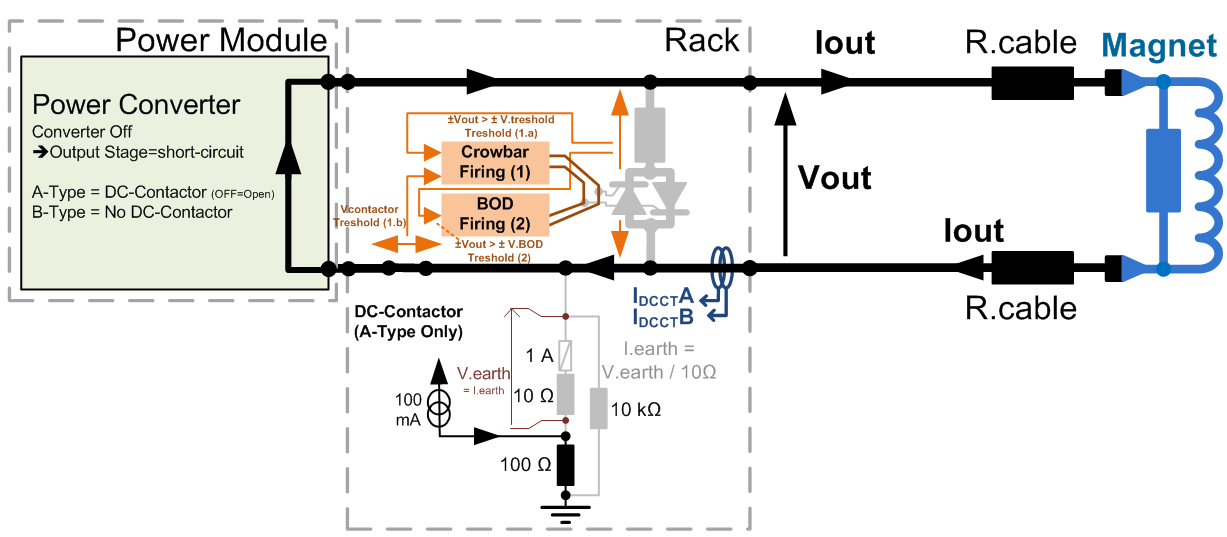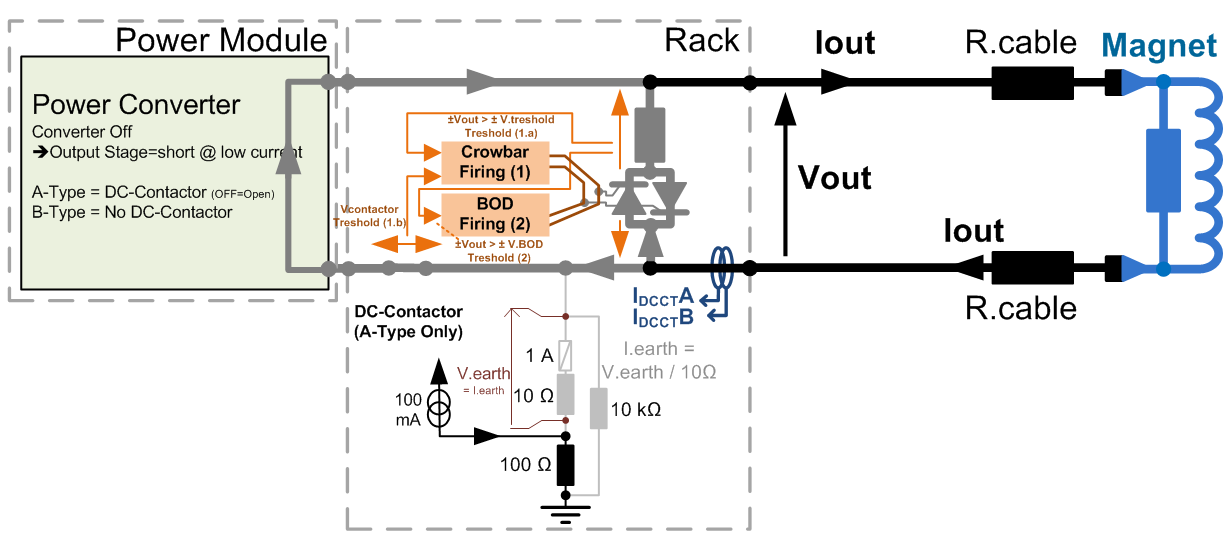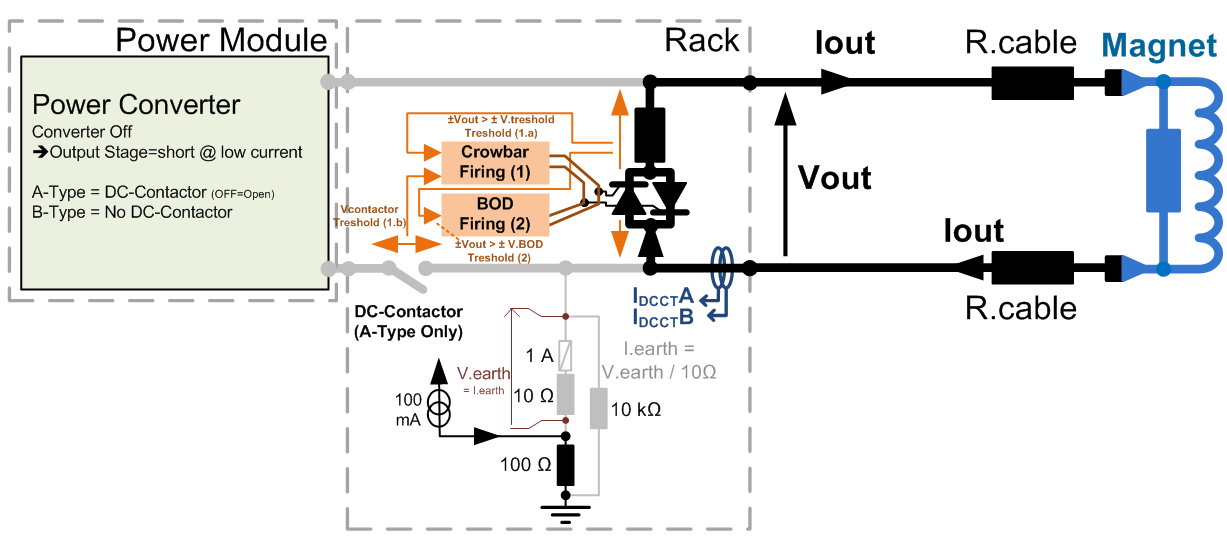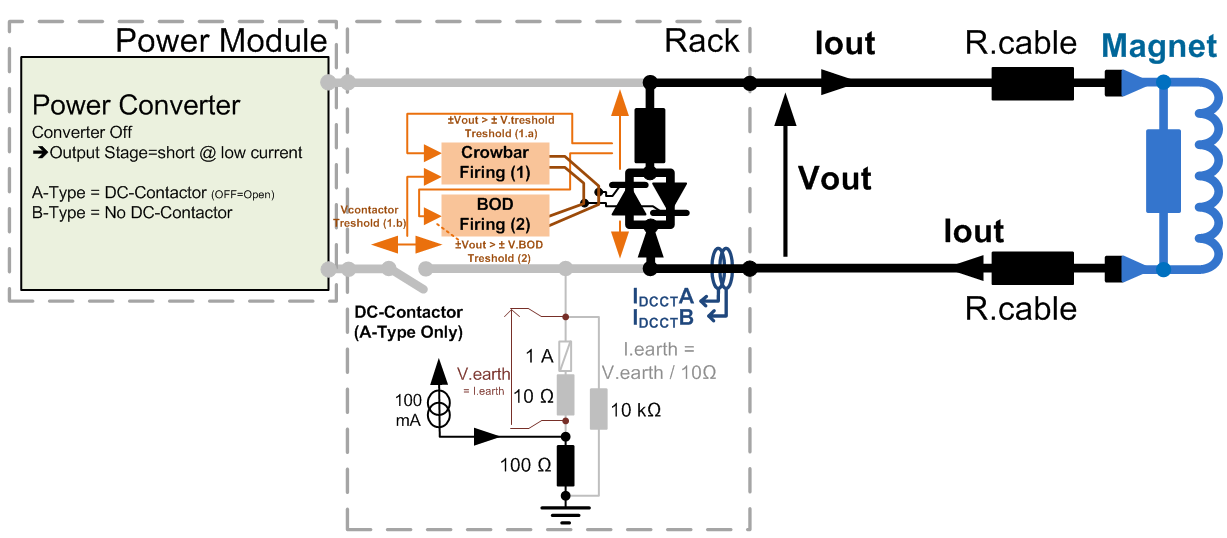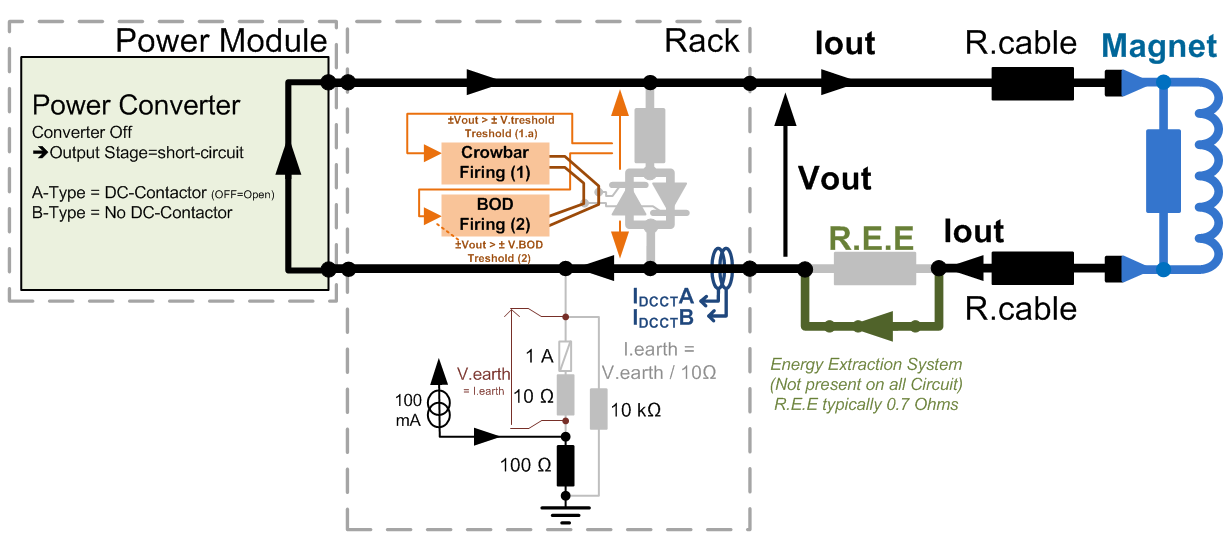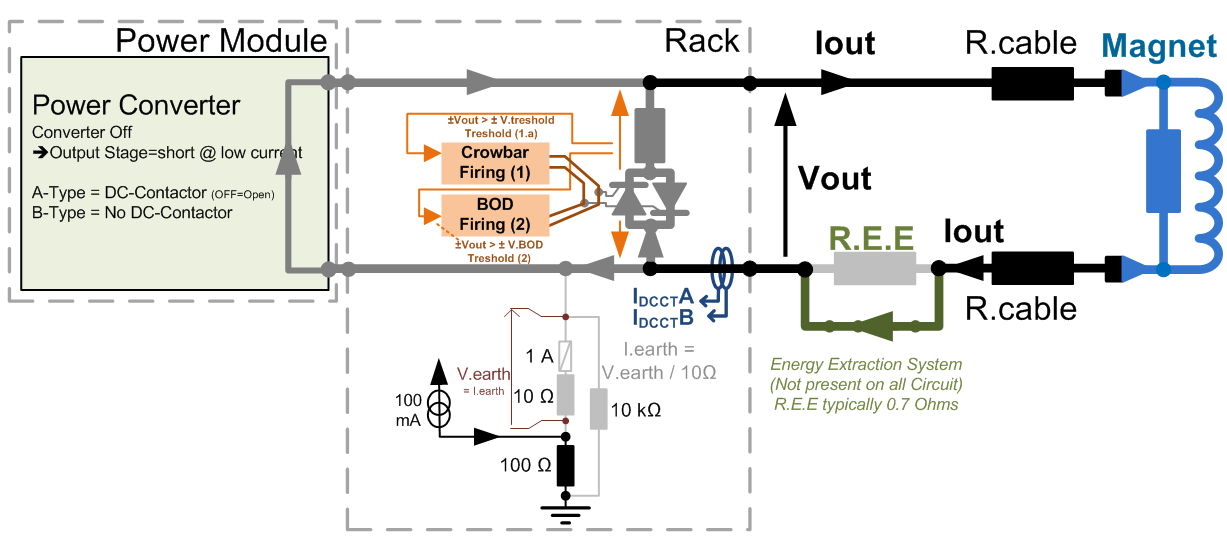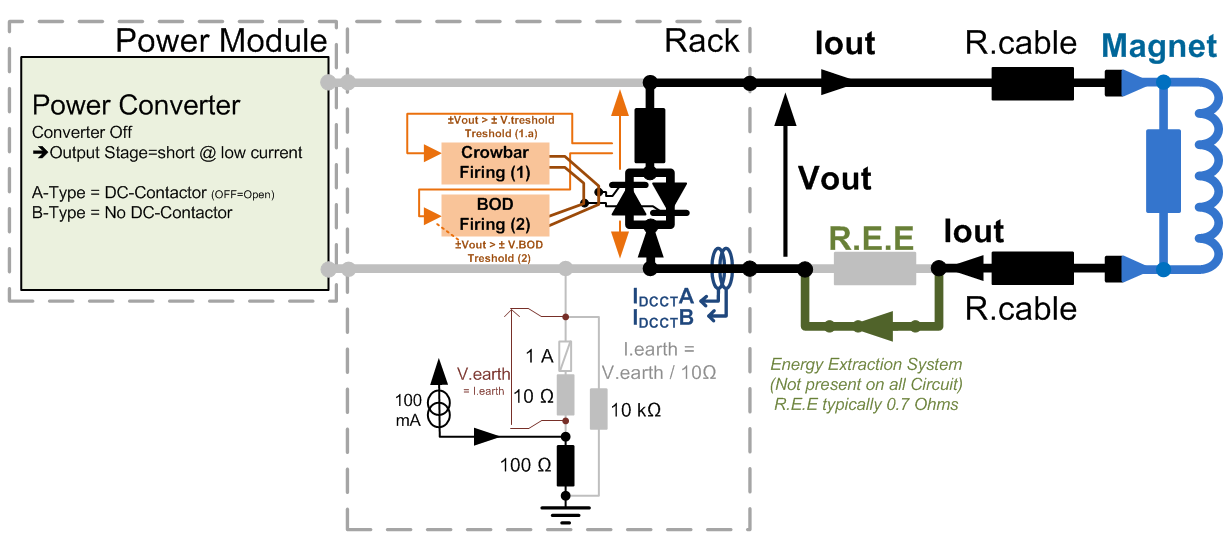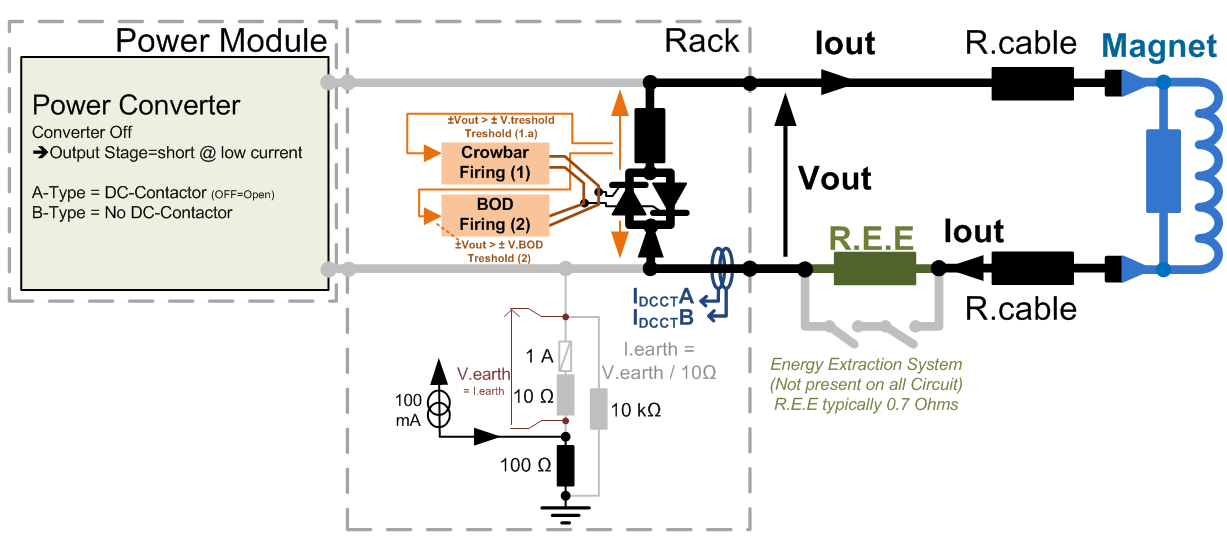|
RPMB(A/B/C) / LHC600A-10V |

|
 |
|
 |
|
 |
CERN
|
SY
|
SY-EPC
|
EDMS
|
PROJECTS
|
ODF
/
OOXML
|
|
CERN
|
SY
|
SY-EPC
|
EDMS
|
PROJECTS
|
ODF
/
OOXML
|

|
|
|
||||||||||||||||||||||||||||||||||||||||||||||||||||||||||||||||||||||||||||||||||||||||||||||||||||||||||
| Power In | 3 ~ 230V/16A |
| Power Out | +/- 600A +/-10V |
| Converter Type | 4 Quadrant |
| Control type | FGC2 / WorldFip |
| Current Accuracy | 10 ppm@ 30 mn |
| 50 ppm@ 24 h | |
| 200 ppm@ 1 year | |
| (1 ppm=0.6mA) |
 Design & Operation Responsibles
Design & Operation Responsibles
| 1st Intervention |
 Piquet SY-EPC LHC
Piquet SY-EPC LHC
|
| Responsibles: |
 Raul BIANCHI
Raul BIANCHI
|
 Yves THUREL
Yves THUREL
|
|
|
|
 Power Converter Architecture
Power Converter Architecture
This Power Converter is used in LHC Machine to power superconductive magnets. It is located in the LHC underground installation, close to the loads to limit cable losses in the underground installation.
Different parts were designed and produced separately, Power Converter being finally integrated in a housing rack, with 3 main parts:
- High Precision Current sensors: DCCTs, able to measure DC current at the required precision.
- Power Part: Power Rack and its removable Power Module
- A Digital Controller (FGC) using WorldFip bus in charge of:
- The high level control from and to the Cern Control Room
- The high precision digital current loop
- Collecting and reporting all status, faults, and measurements from all the different parts to the remote services, for diagnostic and operation purposes.
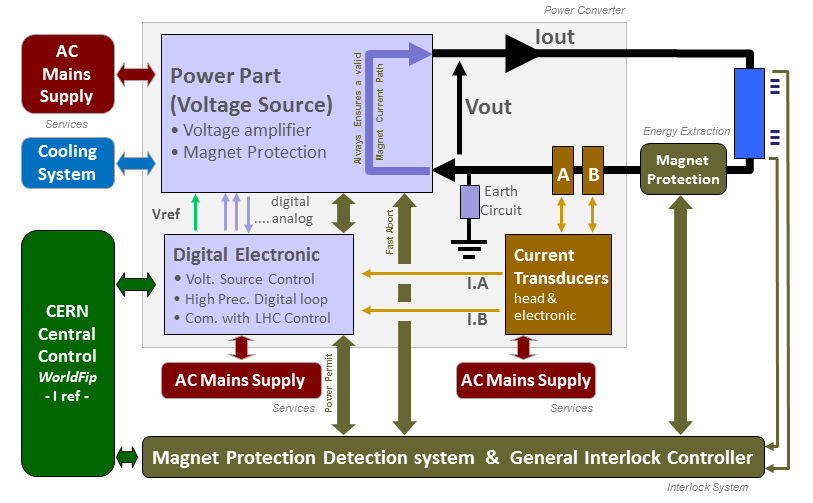
Power Converter simplified Architecture .ppt
 Power Part
Power Part
Voltage Source is based on a variable switching frequency (50kHz..200kHz) half bridge resonnant topology (dual thyristor) followed by a 4 quadrant linear stage to allow the 4 quadrant operation. This topology gives a very low output EMC noise, at a cost of some control complexity given by the different stages.
A 19'' rack provides connectivity from AC network and to the load, housing up to 2 Voltage Source Power Modules.
| Power In | 3 ~ 230V/16A |
| Power Out | +/- 600A +/-10V |
| Cooling type | Water Cooling (+ forced air ventilation) |
| Input rack connection: PARKER SH2-62Y AISI 316 Stainless ¼'' BSPP. (female - blue color "cold") | |
| Output rack connection: PARKER SH2-62Y AISI 316 Stainless ¼'' BSPP. (female - red color "warmer") | |
| Nominal Water Condition [2x 600A modules installed] → 6 l/min @ 3.0 bars of Differential Pressure Drop. * | |
| Nominal Water Condition [1x 600A module installed] → 5 l/min @ 3.0 bars of Differential Pressure Drop. * | |
| Rack Water Layout, and its typical water pressure drop. | |
| Rack2x Losses@ Full Power | Total losses.....4500 Watts [2x(600Ax10V)*(1/0.73-1)]Pwr + 2x65W(FGC+DCCTs) |
| Water losses....3000 Watts | |
| Air losses........1500 Watts (incl. FGC & DCCTs) | |
| Converter Weight | Bare Rack ................ 280 kg (Power Modules and full equipped electronic chassis excluded) |
| Power Module ........... 72 kg | |
| Electronic Chassis .... 11 kg (Fan Tray + Chassis + 2x FGCs + 2x PSUs + 4 DCCT electronics + AC-DC) |

Power Part simplified Architecture / Topology .vsd
3 different types exist A, B, C corresponding to.
- A-Type: Power Module is integrated in rack providing a DC Contactor between Power Module and Rack Crowbar.
- B-Type: Power Module is integrated in rack without any DC Contactor between Power Module and Rack Crowbar.
- C-Type: Power Module is integrated in rack providing a DC Contactor between Power Module and Rack Crowbar, and a external Crowbar placed in a Power Module slot being modified is additionnaly connected (Inner Triplet Case).
Typical Curves
| Curves Meas. Conditions | .txt |
| Output Voltage Ripple | 0A 300A 600A |
| Output Voltage FFT | 0A LF/HF 300A LF/HF 600A LF/HF |
| 0V distortion crossing | -100A/100A -200A/200A -300A/300A -400A/400A -500A/500A -580A/580A |
| Rectified Inverter Current | [0A 0V] [300A 3V] [600A 6V] |
| Earth to DC Polarity Volt. | Earth-Neg DC/AC AC-Neg/AC-Pos |
| Earth to DC Neg Pol. FFT | 0A LF/HF 300A LF/HF 600A LF/HF |
| Starting Sequence Vin.DC | Vin.DC |
| Crowbar/Discharge Curves | 600A Full-sequence - Zoom @ Conditions .txt |
| Fast Abort Delay @ 550A Oscillo - Post-Mortem @ Conditions .txt | |
| Voltage Source Efficiency vs Output Power | Efficiency Graph, (.xlsx) |
 Control Part
Control Part
Control & regulation principles are summarized in a detailled schematics representating only the part involved in the output current regulation scheme.

Regulation Control simplified schematic .vsd
High precision current control loop is managed by the digital controller called FGC (Function Generator Controller). This unit includes a high precision Sigma Delta Analog to Digital Converter which digitalize the analog current measurement coming from 2 DCCTs (DC current Transducer). Precision is then directly relying on sensor precision: DCCT, the ADCs, and the algorithm being used for the regulation loop. Voltage source is then used as a power amplifier, powering the load through a high bandwidth voltage loop (>500Hz).
 Magnet Protection
Magnet Protection
Power Converter is part of magnet protection scheme, even if not directly fully responsible of the monitoring and diagnostic of the superconductive magnet status. Dedicated systems QPS (Quench Protection System) + PIC (Power Interlock Controller) can interlock Power Converter if magnet safety requires it.
Power Converter is expected to:
- Always ensure that external protection system can stop the Power Converter.
Power Converter provide a safe incoming signal called Fast Abort. This redundant signal uses 2 paths to interlock and stop the converter and its redundancy is checked each time it acts. It directly acts on AC and DC Contactor bobbin, ensuring their opening as required. - Stop powering the load always providing a safe path for magnet current.
Magnet current path is ensured through a dedicated system called crowbar when combined with an output DC contactor (Power Module in case its output stage dies in short would collect all magnet current without the DC Contactor). Crowbar active system is located in the rack and provides a safe resistive discharge path for magnet current, with a capability to dissipate, most of the time, part of magnet energy. - Monitor Earth current of the total circuit and take the right action if threshold reached.
Total circuit = converter + load (magnet and its DC cables). - Monitor the voltage across the 2 current leads, and take the right action if threshold reached .
- Crowbar
The system is based on a 50 mOhms Power Resistance series back-to-back thyristors being fired at a given output voltage (±13V), and then providing a safe path for magnet current, providing energy to handle is less than 108 kJ by design. Additional DC-Contactor (Converter type A) ensure that no potential short-circuits at the level of the Power Module can prevent the magnet energy to be actually dissipated in the Crowbar resistance. By the way these additional DC-contators prevent the converter while being in OFF-state to actually deviate some current during magnet discharge (converter output stage is not fully opened in OFF state). One should never forget a Power Module dying with its output stage in short would prevent the crowbar from dissipating magnet energy in the case no DC-Contactor is present.
 No fault
-
No fault
-
 converter → OFF
-
converter → OFF
-
 Crowbar Fully Active
Crowbar Fully Active
A-Type (no REE installed in the circuit). Crowbar System simplified schematic .vsd
 No fault
-
No fault
-
 converter → OFF
-
converter → OFF
-
 Crowbar Fully Active
-
Crowbar Fully Active
-
 REE Active (if required)
REE Active (if required)
B-Type (REE installed in the circuit). Crowbar System simplified schematic .vsd
- Fast Abort Interface
Machine Interlock system can request a Fast Abort to the converter, in case a quench is detected. Converter is then assumed to react as soon and as quick as possible, stopping providing energy to the load. Delay time between a Fast Abort request and actual opening of the 4-quadrant output power stage is less than 1mS, but 20ms, AC Mains Contactor delay time, should be considered as a worst case (internal control malfunction case). A typical sequence could be described as follow:
- t=[=0ms] → Fast Abort Request from Machine Interlock
- t=[=1ms] → Power Converter Output Stage opens and becomes not conductive
- t=[>xms] → Load energy is transfered to the crowbar = a Capacitor up to V.crowbar = ±13V.
Capacitor charge depends on initial load current (I=C.dV/dt). C=C.Crowbar//C.Power-Module - t=[=xms] → Crowbar Thyrsitor is fired, absorbing Crowbar capacitor + Load energy.
An initial over-current generally happens at initial thyristor start-up. - t=[>end] → Load energy is dissipated in the crowbar (R series Thyristor ON voltage) and in the load resistance.
This signal being part of the magnet safety scheme, it is acting redundantely at the level of Converter AC Mains Contactor. 2 paths are used and monitored to stop the contactor.
A possible schematic is described below: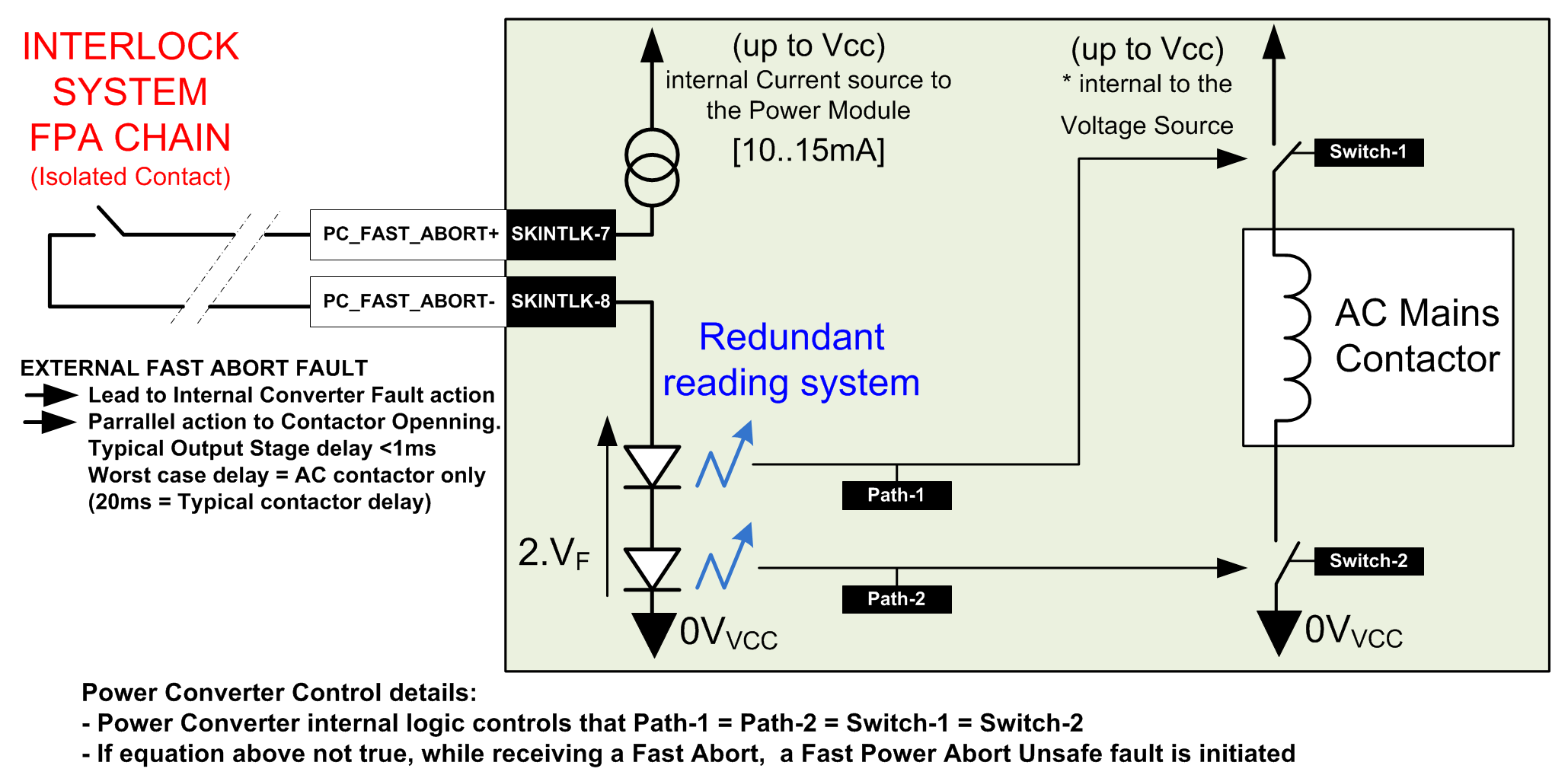
Earthing System simplified schematic .vsd
- Earth System
The circuit injects a 100 mA DC current on a grounded resistive branch, resulting in a common mode voltage at the output circuit easing the earthing fault detection. Output circuit Common mode voltage is, without any earth fault, around 10V (=100 mA x 100 Ohms), and is not relying on load operation, making possible to detect an earth fault even with converter being OFF. (OFF, not condamned).
If an earth fault occurs on the output circuit, a faulty current will be deviated from the initial path back to earth by using the shunt 10 Ohms resistor path (monitored for detecting this fault).
Overcurrent protection is achieved through a 1A-100V fast fuse in series in the path provided for the earthing fault current.
Earth fault current is filtered at the level of the Power Module, and a strong earth fault will make the converter trip 20ms after it happens. See this real measurement curves .png.
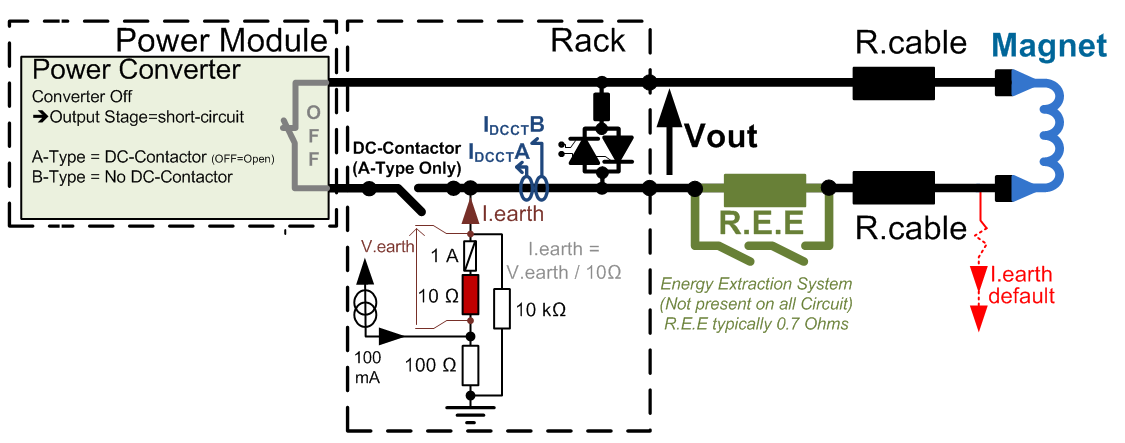
Earthing System simplified schematic .vsd
 Power Converter Components .vsd
Power Converter Components .vsd

A power converter is actually a sum of different equipments under several different sections in the SY-EPC group. The modularity is a key factor for easier maintenance with regards to LHC tunnel access conditions.
Power Converter Rack can accept up to 2 Power Converters. Electronic Chassis, fan tray unit and AC-DC Power Module are shared in such a case.
- Power Converter Rack (up to 2 converters per rack)
- Power Module
- Rack items
- 2x DC Contactors in // and their control card [AE40]
- Current Sensor LEM [...]
- Rack Earthing Card [AA5F]
- Rack Crowbar and its control cards [AA5G + AA5E]
- Rack Center Panel (Display + I.Limits) (back) with its card [AA5D]
- Rack Flowmeter
- FGC2 Fan tray unit
- 2x Current sensors: DCCTs
- Electronic Chassis (Ref: HCRFECA - Type 2) .edms
- Digital Controller: FGC2
- AC/DC Power Module
- PSU FGC Tri-volt
- PSU DCCT Bi-volt
 Magnet Types
Magnet Types
| Orbital corector | QSKxxx |
 Machine Installation
Machine Installation
| Air losses | Full Rack [2x] @ P.nom (incl. FGCs) | 1300Watts |
| Water losses | Full Rack [2x] @ P.nom (incl. FGCs) | 3000Watts |
| P.losses = Module efficiency : 0.75, FGC Chassis : 300Watts. | ||
| LHC Use | 400 Power Converters (144 A-Type, 248 B-Type, 8 C-Type) .xls | |
| Radiation Safe Locations (280) | UA23 (31), UA27 (31), UA43 (24), UA47 (24),
UA63 (23), UA67 (23), UA83 (31), UA87 (31), USC55 (08), UJ33 (46), UL557 (08) |
|
| Radiation Exposed Locations (120) | RR13 (14), RR17 (14), RR53 (14), RR57 (14),
RR73 (24), RR77 (24), UL14 (08), UL16 (08) |
 Production Contract & Contact History
Production Contract & Contact History
| Developped | EEI-CIRTEM |
| 2001-2005 | |
| Manufactured | France-Italy |
| EEI-CIRTEM | |
| Production | 444 Pc |
| CERN Contact |
 Yves THUREL
Yves THUREL
|
 Converter Circuit Names
Converter Circuit Names
| TOP | CHARTE | HTML | CSS | Ver : 04-09-2023 17:14:13 | Webmaster : Michel GEORGES. |

